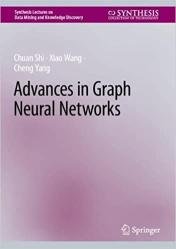Advances in Graph Neural Networks
- Добавил: literator
- Дата: 19-11-2022, 12:39
- Комментариев: 0
 Название: Advances in Graph Neural Networks
Название: Advances in Graph Neural NetworksАвтор: Chuan Shi, Xiao Wang, Cheng Yang
Издательство: Springer
Год: 2023
Страниц: 207
Язык: английский
Формат: pdf (true), epub
Размер: 31.2 MB
This book provides a comprehensive introduction to the foundations and frontiers of graph neural networks. In addition, the book introduces the basic concepts and definitions in graph representation learning and discusses the development of advanced graph representation learning methods with a focus on graph neural networks. The book providers researchers and practitioners with an understanding of the fundamental issues as well as a launch point for discussing the latest trends in the science. The authors emphasize several frontier aspects of graph neural networks and utilize graph data to describe pairwise relations for real-world data from many different domains, including social science, chemistry, and biology. Several frontiers of graph neural networks are introduced, which enable readers to acquire the needed techniques of advances in graph neural networks via theoretical models and real-world applications.
Relational structures are ubiquitous in the real world, such as social relations between people, transaction relations between companies, and biological relations between proteins. Graphs and networks are the most common way to characterize these structured data, where objects/relations are projected into nodes and edges, respectively. With the great success of Machine Learning and Deep Learning techniques, how to numerically represent a graph has become a fundamental problem in network analysis. In particular, graph representation learning, which aims to encode each node in a network into a low-dimensional vector, has attracted much attention during the last decade. More recently, representation learning methods based on graph neural networks (GNNs) show their superiority on various graph-based applications, and become the state-of-the-art paradigm for graph representation learning. GNNs work well for both node-level and graph-level tasks, and immensely contribute to the depth and breadth of the adoption of graph representation learning in real-world applications: ranging from classical graph-based applications such as recommender systems and social network analysis, to new frontiers such as combinational optimization, physics, and health care. The wide applications of GNNs enable diverse contributions and perspectives from disparate disciplines and make this research field truly interdisciplinary.
This book mainly consists of three parts: Fundamental Definitions and Development of GNNs in Part I (Chaps. 1 and 2); Frontier topics about GNNs in Part II (Chaps. 3 and 7), and Future Directions for GNNs in Part III (Chap. 8). The book starts from the basics of graph representation learning, and extensively introduces the cutting-edge research directions of GNNs, including heterogeneous GNNs, dynamic GNNs, hyperbolic GNNs, distilling GNNs, etc. The basic knowledge can help readers quickly understand the merits of GNNs, while the various topics of advanced GNNs are expected to inspire readers to develop their own models. Both beginners and experienced researchers from academia or industry are believed to benefit from the content of this book.
Скачать Advances in Graph Neural Networks
Внимание
Уважаемый посетитель, Вы зашли на сайт как незарегистрированный пользователь.
Мы рекомендуем Вам зарегистрироваться либо войти на сайт под своим именем.
Уважаемый посетитель, Вы зашли на сайт как незарегистрированный пользователь.
Мы рекомендуем Вам зарегистрироваться либо войти на сайт под своим именем.
Информация
Посетители, находящиеся в группе Гости, не могут оставлять комментарии к данной публикации.
Посетители, находящиеся в группе Гости, не могут оставлять комментарии к данной публикации.
